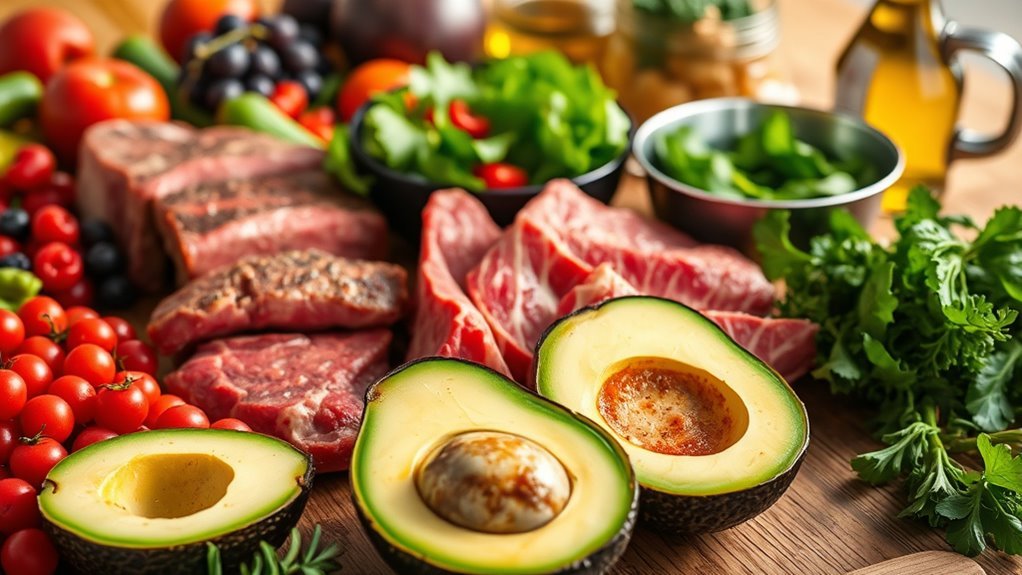To start a keto diet, focus on high-fat, low-carb foods. Include healthy fats like avocados and olive oil, proteins like eggs and grass-fed beef, and low-carb veggies such as spinach and zucchini. Avoid processed foods, sugary drinks, and high-carb snacks. Meal planning and portion control are essential for success. Stay hydrated and consider electrolytes to manage any shift symptoms. There’s more to discover about optimizing your journey and the science behind keto.
Understanding the Ketogenic Diet

The ketogenic diet, often referred to as the keto diet, is a high-fat, low-carbohydrate eating plan that aims to shift your body into a state of ketosis. In this state, your body burns fat for fuel instead of carbohydrates. However, several keto misconceptions can cloud your understanding. For instance, many believe the diet encourages unhealthy eating, but ketogenic science shows it emphasizes whole foods, healthy fats, and adequate protein. By focusing on nutrient-dense options, you can enjoy a variety of meals while promoting your health. It’s essential to educate yourself about the science behind keto to make informed choices that align with your freedom and lifestyle goals. Embrace the journey, and don’t let misunderstandings hold you back!
Benefits of Going Keto

While you might have heard various opinions about the ketogenic diet, numerous studies highlight its potential benefits. Many people find that adopting a keto lifestyle can lead to significant improvements in well-being. Here are three key benefits you might experience:
The ketogenic diet may offer notable benefits, enhancing well-being and promoting a healthier lifestyle.
- Weight Loss: The ketogenic diet often leads to reduced hunger and cravings, making it easier to shed excess pounds.
- Mental Clarity: Many followers report enhanced focus and cognitive function, likely due to the brain using ketones as a more efficient energy source.
- Stable Energy Levels: By relying on fat for fuel, you may notice fewer energy crashes throughout the day, allowing you to maintain productivity without constant snacking.
These benefits can empower you to embrace a healthier lifestyle while enjoying newfound freedom.
Essential Foods to Include

Adopting a keto diet involves more than just cutting carbs; it requires a thoughtful selection of foods that align with your new lifestyle. To thrive on keto, focus on incorporating healthy fats and keto-friendly snacks into your meals. Foods rich in healthy fats, like avocados and olive oil, provide essential nutrients and help keep you satiated.
Here’s a quick reference table of essential foods to include:
| Category | Foods |
|---|---|
| Healthy Fats | Avocado, Olive Oil |
| Proteins | Eggs, Grass-fed Beef |
| Low-Carb Veggies | Spinach, Zucchini |
| Nuts & Seeds | Almonds, Chia Seeds |
| Keto Snacks | Cheese, Pork Rinds |
Foods to Avoid
When you commence a keto diet, knowing which foods to avoid is just as essential as understanding what to include. To truly embrace the low-carb lifestyle, steer clear of:
Understanding which foods to avoid is crucial for successfully adopting a keto diet.
- Processed foods: These often contain hidden sugars and unhealthy fats that can derail your progress.
- High carb snacks: Items like chips and crackers are packed with carbs, making them incompatible with keto.
- Sugary drinks: Soft drinks and fruit juices can spike your sugar intake, so opt for water or unsweetened beverages instead.
Additionally, be mindful of grain limits, starchy vegetables, and fruit restrictions, as they can contribute to your carb count. By avoiding these foods, you’ll create a more effective keto environment for your body.
Tips for a Successful Transition
Shifting to a keto diet can be smoother with some thoughtful preparation. You’ll want to focus on meal planning to guarantee you have the right foods on hand, stay hydrated to support your body’s adjustments, and be aware of the symptoms of keto flu as you start. By addressing these essentials, you can set yourself up for a more successful experience.
Meal Planning Essentials
A successful keto diet starts with thoughtful meal planning, which is vital for easing into this low-carb lifestyle. To set yourself up for success, consider these meal planning essentials:
- Create a Grocery List: Focus on low-carb vegetables, healthy fats, and high-quality proteins. This helps you avoid impulse buys and guarantees you have the right ingredients on hand.
- Practice Portion Control: Measure your servings to maintain the right balance of macronutrients. This guarantees you’re not overindulging, which can hinder your progress.
- Prep Meals Ahead: Spend time preparing meals for the week. This not only saves time but also reduces the temptation to stray from your diet.
Hydration Importance
Staying properly hydrated is essential as you shift to a keto diet, since reduced carbohydrate intake can lead to a loss of water and electrolytes. To maintain your electrolyte balance and guarantee a smooth change, consider these hydration strategies:
| Hydration Strategy | Benefits |
|---|---|
| Drink plenty of water | Supports overall hydration |
| Include electrolytes | Prevents cramping and fatigue |
| Consume broth | Replenishes sodium and potassium |
| Eat hydrating foods | Adds flavor and nutrients |
| Monitor urine color | Indicates hydration level |
Managing Keto Flu
As you commence on your keto journey, it’s important to be aware of the so-called “keto flu,” a collection of symptoms that some experience during the initial phase of reduced carbohydrate intake. Managing these symptoms can help you shift more smoothly. Here are three tips to ease the process:
- Stay Hydrated: Drink plenty of water and consider adding electrolytes to combat dehydration and manage fatigue.
- Gradual Carb Reduction: Slowly decrease your carb intake to minimize keto flu symptoms rather than cutting them out all at once.
- Eat Nutrient-Dense Foods: Focus on high-quality fats and proteins to maintain energy levels and reduce fatigue.
Tracking Your Progress and Adjustments
While starting a keto diet can be exciting, tracking your progress and making necessary adjustments are essential for long-term success. To achieve your goals, you’ll want to establish clear progress metrics, such as weight loss, body measurements, and energy levels. Regularly logging these metrics can keep you motivated and accountable. If you notice a plateau or don’t feel the energy you expected, consider using adjustment strategies like tweaking your macronutrient ratios or incorporating more physical activity. Remember, flexibility is key; the keto diet isn’t a one-size-fits-all approach. Listening to your body and making informed adjustments will enhance your experience and help you find what works best for you, allowing you to embrace the freedom that comes with a successful keto lifestyle.


